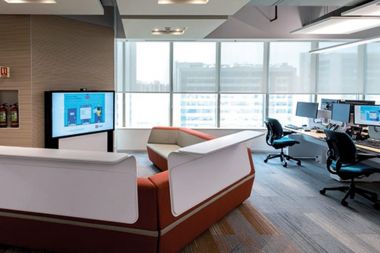Get a work-life balance, at work
Quite clearly a workplace can’t address all the stresses and strains of earning a living, but knowing your employer is trying to help you achieve your career and business goals through investment in the best technology and well-designed spaces contributes positively to employee productivity.

Does your heart sink when you walk into your office every morning? For a sixth of respondents to our latest online poll, on creating effective workplaces, the answer is yes. Another quarter of respondents said that they do good work in spite of their office environment, not because of it.
Frankly their employers are lucky that they still work there at all, because in today’s commercial world, sub-standard working conditions are simply bad for business.
“Most employees want to feel they’re working for a forward thinking, ambitious company, and a working environment that reflects this encourages productivity and staff retention,” says Stuart Davidson, technical services director at AVMI. “Businesses often have to sell themselves to potential employees as much as the other way round, and the working environment is absolutely vital in achieving this.”
“The upcoming ‘Generation Y’, or millennials, are choosing workplaces based on the flexibility and technology they offer over salary,” adds Jasmin Stemmler, product marketing manager at NEC Display Solutions Europe.
So what will potential recruits want to see when they size up your office after you’ve sized them up at the interview? Top of the list, according to our poll respondents, is a degree of choice over where and how to work.
“A choice of work environment is important,” says Tony Crossley, special projects director at Pure Audio Visual. “Most of us have a variety of tasks to achieve each day, some requiring collaboration with colleagues, others demanding independent, focused working. The ability to move between quiet spaces, informal and formal work environments, combined with remote working according to the job in hand, boosts not only productivity but also satisfaction.”
Jayne Cox, stress management consultant at workplace specialist Fusion Spaces, calls it “free range” working, as opposed to the “factory farmed” approach of chaining people to a single desk.
“Spending time in a seat all day will become a thing of the past for many organisations,” she believes. “The human animal is designed to move around, so more agile working with more movement throughout the day will no longer be unusual, and we envisage that workspaces will be designed to increase natural human movement.”
“In my experience the vast majority of companies still use desks in the traditional way,” says Jon Knight, commercial director at Ascentae. “But there’s certainly an increasing desire to move towards the agile workplace with activity-based working. This involves spaces being broken down into zones specifically designed for different tasks, such as video conferencing rooms, project rooms, command rooms and brainstorming rooms.
“Some companies struggle to see how you can offer such working practices to certain job roles such as data entry clerks. But in every job there’s a need to move about. By designing space to accommodate activity-based working, the employer is recognising, accommodating and ultimately encouraging that. And cloud based systems mean that data can be entered from anywhere with an internet connection.”
Read the full article here
Visit the AV Magazine website to stay up-to-date with all the latest AV industry news.
Posted: 21st January 2020